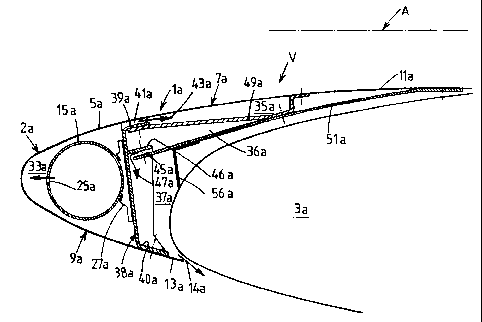Some of the information on this Web page has been provided by external sources. The Government of Canada is not responsible for the accuracy, reliability or currency of the information supplied by external sources. Users wishing to rely upon this information should consult directly with the source of the information. Content provided by external sources is not subject to official languages, privacy and accessibility requirements.
Any discrepancies in the text and image of the Claims and Abstract are due to differing posting times. Text of the Claims and Abstract are posted:
| (12) Patent: | (11) CA 2330397 |
|---|---|
| (54) English Title: | AIRCRAFT AIRFOIL LEADING EDGE MEMBER EQUIPPED WITH A DE-ICING DEVICE |
| (54) French Title: | PIECE DE BORD D'ATTAQUE DE LA SURFACE PORTANTE D'UN AERONEF MUNIE D'UN DISPOSITIF DE DEGIVRAGE |
| Status: | Expired and beyond the Period of Reversal |
| (51) International Patent Classification (IPC): |
|
|---|---|
| (72) Inventors : |
|
| (73) Owners : |
|
| (71) Applicants : |
|
| (74) Agent: | SMART & BIGGAR LP |
| (74) Associate agent: | |
| (45) Issued: | 2008-10-28 |
| (22) Filed Date: | 2001-01-09 |
| (41) Open to Public Inspection: | 2001-07-17 |
| Examination requested: | 2006-01-06 |
| Availability of licence: | N/A |
| Dedicated to the Public: | N/A |
| (25) Language of filing: | English |
| Patent Cooperation Treaty (PCT): | No |
|---|
| (30) Application Priority Data: | ||||||
|---|---|---|---|---|---|---|
|
A leading edge member (1a) of an airfoil (V) of an aircraft has an outside wall (5a) and a de-icing device of the type for circulating hot air in the direction of the span of said airfoil. Said device includes a) a hot air distribution duct (15a) extending inside said leading edge member in said direction and having a plurality of orifices (25a) distributed over at least part of its length, and b) hot air supply means (19a) communicating with one end (17a) of said distribution duct (15a; 15b). Said hot air supply means (19a) are adapted to be connected by ducts (C) located outside said leading edge member to at least one propulsion engine (M) of said aircraft.
Une pièce de bord d'attaque (1a) d'une surface portante (V) d'un aéronef a une paroi extérieure (5a) et un dispositif de dégivrage du type qui sert à la circulation de l'air chaud dans la direction de l'envergure de ladite surface portante. Ledit dispositif comprend a) une canalisation de distribution d'air chaud (15a) qui traverse ladite pièce de bord d'attaque dans ladite direction et ayant une pluralité d'orifices (25a) disposés sur au moins une partie de sa longueur, et b) un dispositif d'approvisionnement d'air chaud (19a) qui communique avec une extrémité (17a) de ladite canalisation de distribution (15a; 15b). Lesdits dispositifs d'approvisionnement d'air chaud (19a) sont adaptés pour être reliés par des canalisations (C) situées à l'extérieur de la pièce de bord d'attaque à au moins un moteur de propulsion (M) dudit aéronef.
Note: Claims are shown in the official language in which they were submitted.
Note: Descriptions are shown in the official language in which they were submitted.

2024-08-01:As part of the Next Generation Patents (NGP) transition, the Canadian Patents Database (CPD) now contains a more detailed Event History, which replicates the Event Log of our new back-office solution.
Please note that "Inactive:" events refers to events no longer in use in our new back-office solution.
For a clearer understanding of the status of the application/patent presented on this page, the site Disclaimer , as well as the definitions for Patent , Event History , Maintenance Fee and Payment History should be consulted.
| Description | Date |
|---|---|
| Time Limit for Reversal Expired | 2018-01-09 |
| Letter Sent | 2017-01-09 |
| Grant by Issuance | 2008-10-28 |
| Inactive: Cover page published | 2008-10-27 |
| Inactive: Final fee received | 2008-08-13 |
| Pre-grant | 2008-08-13 |
| Notice of Allowance is Issued | 2008-04-17 |
| Letter Sent | 2008-04-17 |
| Notice of Allowance is Issued | 2008-04-17 |
| Inactive: IPC assigned | 2008-04-15 |
| Inactive: IPC removed | 2008-04-15 |
| Inactive: First IPC assigned | 2008-04-15 |
| Inactive: IPC assigned | 2008-04-15 |
| Inactive: Approved for allowance (AFA) | 2008-02-20 |
| Amendment Received - Voluntary Amendment | 2006-06-27 |
| Letter Sent | 2006-01-23 |
| Request for Examination Requirements Determined Compliant | 2006-01-06 |
| All Requirements for Examination Determined Compliant | 2006-01-06 |
| Request for Examination Received | 2006-01-06 |
| Amendment Received - Voluntary Amendment | 2006-01-05 |
| Inactive: Cover page published | 2001-07-25 |
| Application Published (Open to Public Inspection) | 2001-07-17 |
| Inactive: First IPC assigned | 2001-03-30 |
| Inactive: Courtesy letter - Evidence | 2001-03-06 |
| Inactive: Filing certificate - No RFE (English) | 2001-02-09 |
| Filing Requirements Determined Compliant | 2001-02-09 |
| Letter Sent | 2001-02-09 |
| Application Received - Regular National | 2001-02-08 |
There is no abandonment history.
The last payment was received on 2007-12-19
Note : If the full payment has not been received on or before the date indicated, a further fee may be required which may be one of the following
Please refer to the CIPO Patent Fees web page to see all current fee amounts.
Note: Records showing the ownership history in alphabetical order.
| Current Owners on Record |
|---|
| DASSAULT AVIATION |
| Past Owners on Record |
|---|
| PAUL LAUGT |